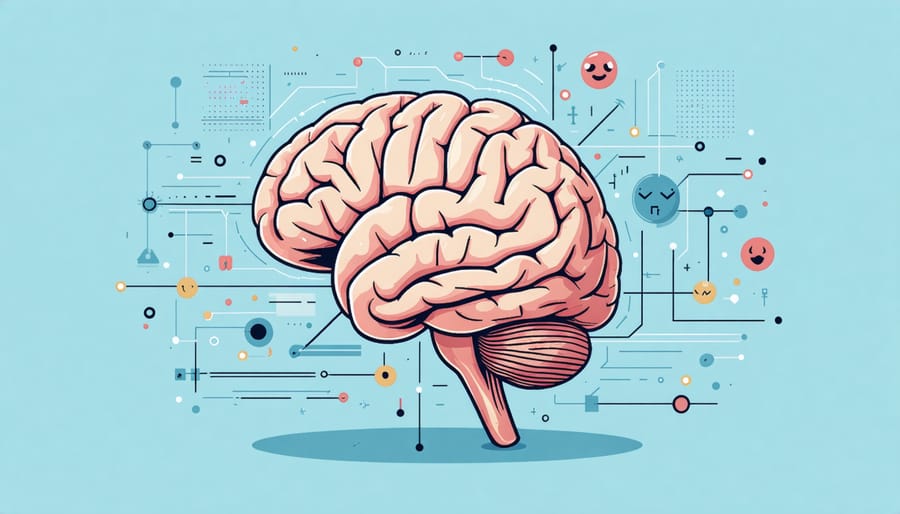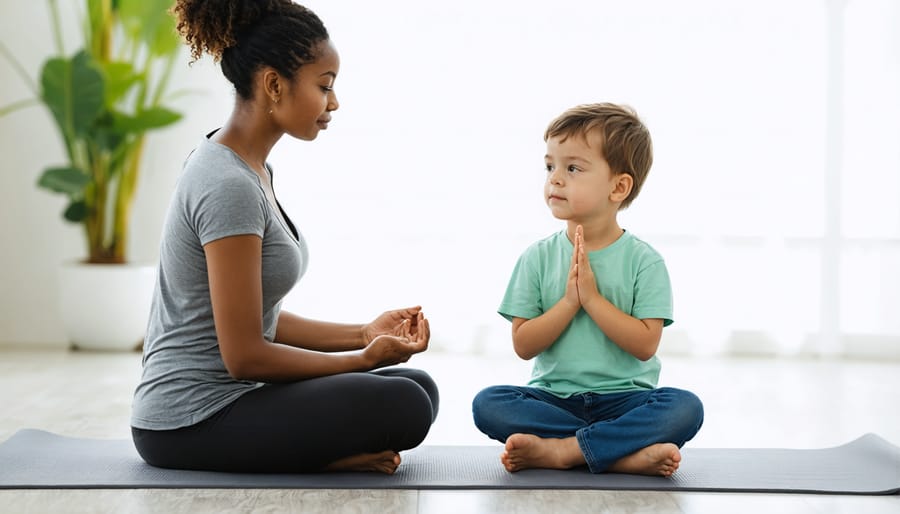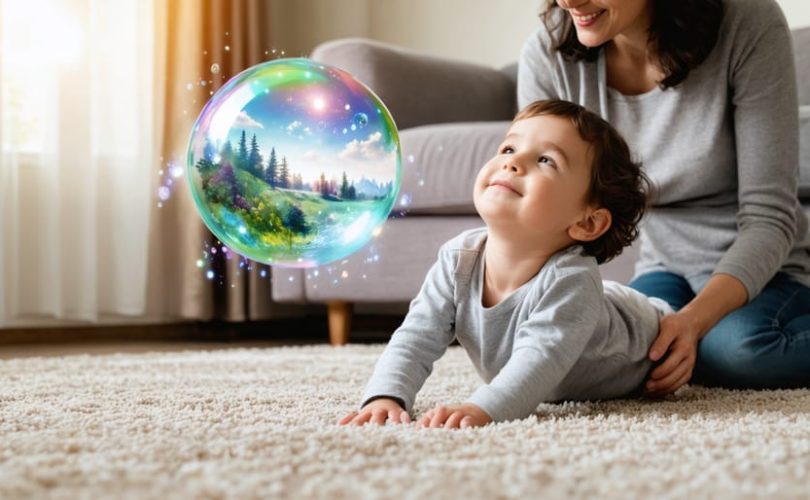The remarkable connection between our minds and bodies shapes every aspect of our children’s wellbeing, from their emotional resilience to their physical health. When a child feels anxious, their stomach might hurt; when they’re excited, their energy levels soar – these aren’t coincidences, but powerful examples of how thoughts and emotions directly influence physical health.
As parents and caregivers, understanding this intricate relationship opens up transformative opportunities to support our children’s development. Research shows that simple mind-body techniques can help children manage stress, improve focus, and build emotional awareness. From guided breathing exercises that calm an overwhelming moment to movement-based activities that boost mood, these practical tools work because they tap into the brain’s natural ability to influence bodily functions.
What makes this connection particularly fascinating is how early intervention with mind-body practices can establish lifelong patterns of emotional regulation and self-awareness. When children learn to recognize and respond to their body’s signals, they develop stronger coping skills and greater emotional intelligence. This powerful mind-body awareness becomes their foundation for navigating life’s challenges with confidence and resilience.
Let’s explore how we can harness this connection to help our children thrive, using simple, evidence-based strategies that fit naturally into daily family life.
Understanding the Mind-Body Connection in Children
How Children Process Emotions Physically
Children experience emotions not just in their minds but throughout their entire bodies. When experiencing strong feelings, many children complain of stomach aches, headaches, or tension in their muscles. This physical manifestation of emotions is particularly common in cases of anxiety in children, where they might feel butterflies in their stomach or a racing heart.
Dr. Sarah Chen, a child psychologist, explains, “Young bodies are incredibly responsive to emotional states. A child who’s worried about a test might experience nausea, while excitement about a birthday party could lead to boundless energy and difficulty sitting still.”
Parents often notice these physical responses in their children’s everyday behaviors. A stressed child might clench their fists, hunch their shoulders, or experience changes in appetite and sleep patterns. Some children may become more physically active when upset, while others might withdraw and feel physically drained.
Understanding these physical manifestations helps parents and caregivers better support their children through emotional experiences and recognize when they might need additional help or comfort.
The Science Behind Mind-Body Connection
Our brains and bodies are connected in remarkable ways, especially during childhood development. When a child feels anxious, their heart might race, or their stomach might feel uneasy. These physical responses aren’t just coincidences – they’re clear examples of how thoughts and emotions directly affect our bodies.
Research shows that when children experience stress or strong emotions, their bodies release hormones like cortisol and adrenaline. These chemicals can influence everything from heart rate and breathing to digestion and immune system function. At the same time, physical sensations can also trigger emotional responses in the brain, creating a two-way communication system.
This connection is particularly strong in children because their nervous systems are still developing. When a child feels safe and calm, their body responds by releasing feel-good hormones like oxytocin and serotonin, which promote healing and growth. Similarly, simple physical activities like deep breathing or gentle movement can help calm an anxious mind.
Understanding this connection helps parents and caregivers better support children’s overall wellbeing through both physical and emotional approaches.

Effective Mind-Body Techniques for Children
Mindful Breathing Exercises
Breathing is one of the most powerful tools we have for connecting our minds and bodies, especially when helping children manage stress and anxiety. Simple breathing exercises can make a significant difference in how both adults and children respond to challenging situations.
Start with the “Balloon Breath” – imagine your belly is a balloon that slowly inflates as you breathe in through your nose and deflates as you exhale through your mouth. This technique pairs wonderfully with other children’s meditation techniques and can be practiced anywhere, anytime.
Another effective method is “Square Breathing.” Visualize tracing a square with your breath: inhale for four counts, hold for four, exhale for four, and hold for four. This structured approach helps regulate the nervous system and brings a sense of calm and focus.
For younger children, try “Bear Breathing” – pretend to be a sleepy bear taking slow, deep breaths during hibernation. This playful approach makes the exercise more engaging while delivering the same calming benefits. Remember to practice these exercises regularly, not just during stressful moments, to build a strong foundation for emotional regulation.

Child-Friendly Yoga and Movement
Movement and yoga offer powerful tools for helping children connect with their bodies and manage their emotions. Through gentle, child-friendly yoga poses and playful movement activities, kids can develop body awareness, emotional regulation, and stress management skills in an engaging way.
Simple practices like “animal walks” (moving like different creatures), breathing exercises disguised as games, and calming stretches can help children tune into their physical sensations while having fun. For example, “butterfly breathing” involves sitting cross-legged, fluttering the legs like wings, and taking deep breaths – making mindfulness naturally appealing to young minds.
Dance parties, freeze games, and guided movement stories also provide opportunities for children to release energy, process feelings, and practice mindfulness through play. These activities can be especially helpful during transitions or when children feel overwhelmed.
Parents and teachers can incorporate these movements throughout the day, whether as morning energizers, calm-down techniques, or bedtime routines. The key is keeping activities age-appropriate and presenting them as playful explorations rather than strict exercises.
Progressive Muscle Relaxation
Progressive muscle relaxation is a gentle and effective technique that can help children learn to manage stress and anxiety through body awareness. Think of it as a peaceful journey through the body, where kids can imagine releasing tension like deflating a balloon or relaxing tight muscles like soft spaghetti.
To guide your child through this exercise, have them lie down comfortably in a quiet space. Start with their toes, asking them to squeeze them tight for 5 seconds, then completely relax them. Move slowly up through their body – feet, legs, tummy, hands, arms, shoulders, and face – repeating the same pattern of tension and release.
Make it playful by using age-appropriate imagery: “Squeeze your hands like you’re squeezing oranges to make juice, then let all the juice drip away” or “Scrunch your face up like a grumpy monster, then let it melt into a happy smile.”
Many parents report that this technique helps their children fall asleep more easily and feel calmer during challenging situations. Practice this exercise regularly, ideally for 5-10 minutes daily, to help your child develop this valuable self-regulation skill.
Creative Visualization
Creative visualization is a powerful technique that helps children and adults harness their imagination to manage emotions and reduce stress. Think of it as creating a mental movie where you’re the director, choosing peaceful scenes that bring comfort and calm. For instance, a child feeling anxious about a test might imagine themselves in a peaceful garden, surrounded by butterflies and gentle sunshine.
Parents can guide their children through simple visualization exercises, such as imagining a favorite place or picturing themselves succeeding at a challenging task. One popular approach is the “balloon breath” technique, where children visualize their worries floating away in colorful balloons while taking deep breaths.
Research shows that regular creative visualization practice can help reduce anxiety, improve focus, and boost confidence. Dr. Sarah Chen, a child psychologist, notes, “When children learn to use their imagination positively, they develop a valuable emotional regulation tool they can use anywhere, anytime.”
To get started, find a quiet space, close your eyes, and spend just 5-10 minutes creating peaceful mental images. With practice, this technique becomes easier and more effective.
Implementing Mind-Body Practices at Home
Creating a Supportive Environment
Creating a supportive environment is essential for strengthening the mind-body connection. Start by designating a quiet, comfortable space in your home where you can practice mindfulness and relaxation techniques without interruption. This area should be free from electronic distractions and decorated with calming elements like soft lighting, comfortable cushions, or peaceful artwork.
Establish a consistent daily routine that incorporates mind-body practices. This might include morning stretches, afternoon breathing exercises, or evening meditation. When children know what to expect, they feel more secure and are more likely to engage in these beneficial activities.
Consider incorporating natural elements into your space, such as plants or a small indoor fountain. These elements can help create a more grounding atmosphere and promote a sense of connection with nature. Temperature and lighting also play crucial roles – aim for comfortable room temperature and adjustable lighting that can be dimmed for relaxation exercises.
Sound management is equally important. Some people benefit from complete silence, while others prefer soft background music or nature sounds. Keep helpful tools readily available, such as yoga mats, meditation cushions, or stress balls. Remember that this space should evolve with your needs and preferences – what works today might need adjustment tomorrow.
The key is creating an environment that signals to both mind and body that it’s time to slow down, connect, and heal.

Making it Fun and Engaging
Turning mind-body connection activities into enjoyable experiences is key to helping children embrace these practices. Consider transforming breathing exercises into bubble-blowing games, where children can practice deep breaths while creating beautiful soap bubbles. For younger children, animal-themed yoga poses can spark imagination – becoming a mighty lion or a graceful butterfly makes movement more engaging.
Create a “feelings corner” with comfort items like soft pillows, stress balls, and calming artwork where children can practice mindfulness through sensory exploration. Music can also play a powerful role – try “body scan” exercises where children lie down and wiggle different body parts to their favorite songs.
Make meditation accessible through storytelling – guide children through peaceful visualization journeys to magical places or have them imagine their thoughts as passing clouds in the sky. For more active children, try “mindful movement” games like freeze dance or simon says that combine physical activity with body awareness.
Remember to praise effort over perfection and make it okay to giggle or be silly during these activities. When children associate mind-body practices with fun and positive emotions, they’re more likely to develop lasting healthy habits. Consider creating a “relaxation reward chart” where children earn stickers for trying different techniques, making the learning process both motivating and entertaining.
When to Seek Professional Help
While mind-body practices can be incredibly beneficial for mental wellness, there are times when additional professional support becomes necessary. Being attentive to signs of mental health concerns in yourself or your loved ones is crucial for timely intervention.
Consider seeking professional help if you notice:
– Physical symptoms persist despite using mind-body techniques
– Emotional distress interferes with daily activities
– Sleep patterns are significantly disrupted
– Anxiety or depression symptoms worsen
– Relationship difficulties become overwhelming
– Mind-body practices trigger unexpected emotional responses
Dr. Sarah Martinez, a child psychologist, shares: “While meditation and breathing exercises are valuable tools, they work best alongside professional care when dealing with significant mental health challenges. Think of it like building a house – mind-body practices are excellent foundation work, but sometimes you need an architect’s expertise.”
Professional support can enhance your mind-body practice by:
– Providing personalized strategies tailored to your needs
– Offering expert guidance on technique modification
– Helping process underlying emotional issues
– Creating a comprehensive wellness plan
– Ensuring safe practice for your specific situation
Remember, seeking help is a sign of strength, not weakness. Many mental health professionals now integrate mind-body approaches into their treatment plans, creating a holistic approach to wellness. They can help you understand when and how to use these techniques most effectively while addressing deeper concerns.
If you’re unsure about whether to seek help, consider scheduling a consultation with a mental health professional who has experience in mind-body approaches. They can assess your situation and recommend the most appropriate combination of treatments and practices for your unique circumstances.
Understanding and nurturing the mind-body connection is a powerful tool for supporting children’s mental health and overall well-being. As we’ve explored throughout this article, the relationship between our thoughts, emotions, and physical health is deeply interconnected and significantly impacts our children’s development.
By implementing simple mind-body techniques like deep breathing, mindful movement, and emotional awareness exercises, we can help our children build resilience and develop healthy coping mechanisms that will serve them throughout their lives. Remember that these practices don’t require special equipment or extensive training – just patience, consistency, and a supportive approach.
As parents, teachers, and caregivers, we play a crucial role in modeling these behaviors and creating environments that support both mental and physical wellness. Start small, perhaps with a daily five-minute mindfulness practice or gentle yoga session, and gradually build upon these foundations as your child becomes more comfortable with these techniques.
The beauty of mind-body practices lies in their accessibility and adaptability. Every child is unique, so feel free to modify these approaches to suit your child’s needs and interests. Whether through creative movement, breathing games, or quiet reflection time, the key is to make these practices enjoyable and sustainable.
By investing in our children’s mind-body wellness today, we’re helping them develop valuable life skills that will support their mental and physical health for years to come.

